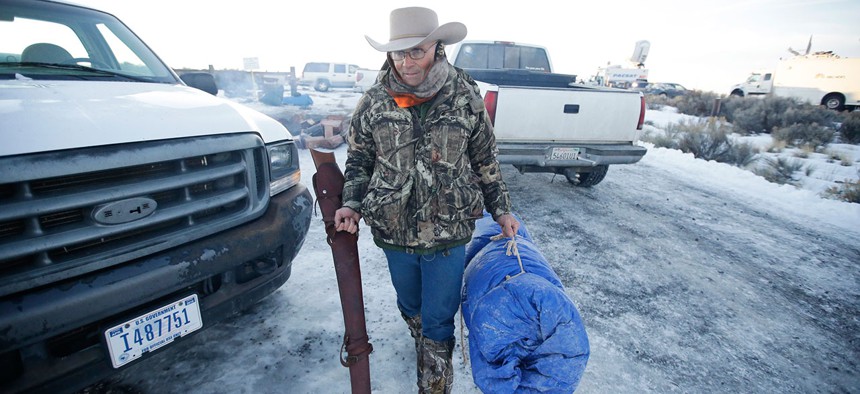
LaVoy Finicum carries his rifle after standing guard all night at the Malheur National Wildlife Refuge in January. Rick Bowmer/AP
Did FBI Agents Lie About LaVoy Finicum's Shooting?
An investigation shows two unaccounted-for shots, apparently fired by federal officers—and suggestions they tried to cover them up.
Given that it involved a weeks-long occupation of federal property by armed men, facing off against equally armed law enforcement, the standoff at Malheur National Wildlife Refuge in Oregon ended almost as well as could be hoped—with the ringleaders, as well as Cliven Bundy, in jail, the refuge cleared, and only one death: that of LaVoy Finicum.
Finicum, who had become a de facto spokesman for the occupation, was shot on January 26 when Oregon State Police and FBI intercepted two cars that occupiers were driving to John Day, a nearby town . Both cars stopped. The occupants of one car surrendered, but Finicum, driving the other, drove ahead. When he encountered a roadblock, he tried to drive around it, but his SUV became lodged in snow. This was his vehicle’s second stop. Finicum jumped out of the vehicle and was shot. Even that shooting struck many observers as justified: Finicum had nearly hit agents with the truck, and as he was shot he was reaching for a pocket where a gun was found.
But now the clean finish isn’t looking so clean after all. A three-county investigation that wrapped up last week found that Finicum’s shooting by Oregon State Police was justified , but it also revealed the existence of two mystery shots, apparently fired by FBI agents. OSP officers apparently shot six shots—three at the truck as it barreled toward the roadblock, and then another three that struck Finicum after he left the car. But a cellphone recording by one of the people in the car, 18-year-old Shawna Cox, revealed two other shots, one of which blew out a window.
The problem is that FBI agents did not tell investigators they had fired the shots. Reportedly no one inventoried the FBI agents’ guns because none of the other people present had seen them shoot, and they didn’t say they had. Worse, there's some reason to believe the shots were intentionally concealed, The Oregonian reports . A state trooper reported seeing two bullet casings on the ground after the shooting. Those casings were copper-colored, while OSP uses only silver-colored casings. But those copper-colored casings were not found later in a sweep of the site.
Greg Bretzing, the FBI agent in charge of Oregon, issued a statement acknowledging the discrepancy :
The county’s investigation also indicated that, in between the two series of shots fired by OSP troopers, one, and possibly two, additional shots were fired by law enforcement as Mr. Finicum was exiting the vehicle after hitting the snow bank. As autopsy results confirm, neither of these shots struck Mr. Finicum. The question of who fired these shots has not been resolved. Upon learning this, and given the FBI presence on scene, I immediately contacted our Inspection Division which notified the United States Department of Justice’s Office of Inspector General which is currently investigating this matter.
Officials also released the video Cox shot. It’s a counterpart of the FBI’s video, which was filmed from a surveillance plane, and does a good job of capturing the broad outlines of the incident but little to illuminate the details. Cox’s video is also limited—it reveals some details about Finicum and the crash before he was shot, but it’s tough to tell what’s going on outside the truck.
The footage shows Finicum taunting officers during the first stop, when both vehicles were intercepted, holding his arms outside the window and telling them to go ahead and shoot him if they pleased but that he intended to go meet the Grant County sheriff in John Day. The passengers are heard complaining they don’t have cell service to get in touch with other people on the remote road. Then Finicum tells everyone to get down and guns the engine—unbeknownst to him, directly toward the roadblock.
“Hang on! Hang on!” Finicum says. Then comes the impact—and the second stop. He jumps out of the car and shouts, “Go ahead and shoot me!”
The people in the car scream as gunshots ring out and try to figure out what’s happening outside the car. There are sounds of explosions—possibly flash-bang grenades—and smoke starts to fill the car. The passengers still in the car can see the laser sights on guns dancing around the car. “I don’t dare get out, ’cause they’ll shoot me,” one woman says. The video then ends.
The four FBI agents were part of the bureau’s elite Hostage Rescue Team. As The Washington Post reports , the operators were shadowy and mysterious even to the state police working alongside them.
The revelations threaten to cast a new pall over the team. During the 1990s, the HRT was implicated in the two disasters at Waco and Ruby Ridge, where the government was universally acknowledged to have bungled standoffs. Those experiences were often cited as a reason for the FBI’s notably hands-off approach to the Malheur situation—keeping a distance, letting people come and go, and allowing the occupation to run for weeks. The general positive reaction to the standoff seemed to suggest a return to good graces for the HRT. The hiccups in the investigation point to what might be another blemish for the team—even as the rest of the occupation was resolved effectively.






